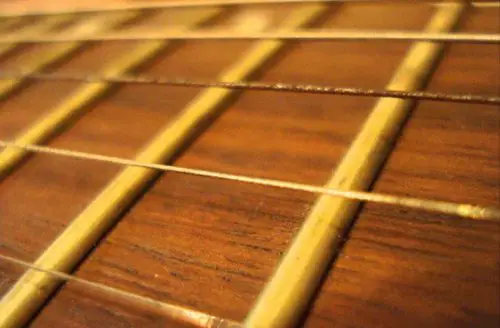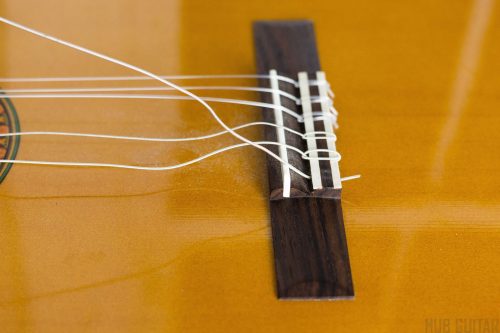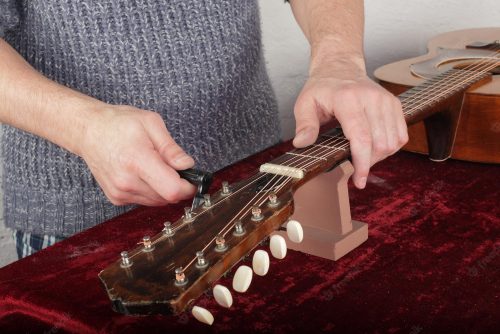Old guitar strings can indeed lose intonation over time. The intonation of a string refers to its ability to produce accurate pitches and maintain proper tuning across the fretboard. As strings age and are subjected to frequent playing, environmental factors, and variations in tension, their intonation can gradually deteriorate.
One of the main reasons why old guitar strings lose intonation is due to the build-up of dirt, oils, and grime on the strings. This accumulation can cause the strings to become less flexible and more rigid, making it difficult for them to vibrate freely and produce accurate pitches.
Furthermore, the build-up of dirt can affect the contact points between the strings and the frets, leading to inconsistencies in intonation.
Another factor that can cause old strings to lose intonation is the gradual stretching of the strings over time. When a string is first installed, it undergoes a process known as “settling” where it stretches and adapts to the tension of the guitar.
However, as the strings age and are continually subjected to tension changes during tuning and playing, they can stretch further and lose their initial balance. This stretching can result in a deviation in intonation, causing the guitar to sound out of tune, especially when playing higher up the fretboard.
Furthermore, as strings age, their metal composition can also affect their intonation. Over time, the metal can start to corrode, leading to changes in the string’s density and elasticity. These changes can result in altered vibration patterns and subsequently affect the pitch accuracy and intonation of the strings.
To maintain good intonation, it is recommended to regularly replace your guitar strings, especially if you notice a decline in their overall performance. Changing your strings regularly not only helps to preserve a brighter and more vibrant tone but also ensures that your guitar maintains better intonation throughout the fretboard.
By understanding the factors that can cause old guitar strings to lose intonation, musicians can take appropriate measures to keep their instruments sounding their best. Regular cleaning, proper string installation, and timely string changes can help minimize intonation issues and ensure consistent and accurate tuning across the guitar’s fretboard.
Here’s a summary that sums up the entire article if you are too busy. Otherwise, read till the end because there are much more to the topic!
| Subheader | Summary |
|---|---|
| Do old guitar strings lose intonation? | Yes, old guitar strings can lose intonation due to dirt buildup, stretching, and changes in the metal composition. Regularly changing strings helps maintain better intonation. |
| Do old guitar strings affect tone? | Yes, old guitar strings can affect the tone by becoming dull and losing vibrancy. Regularly changing strings helps maintain a fresh and vibrant tone. |
| Will new strings fix intonation? | New strings can improve intonation by eliminating dirt and stretching issues, but other factors like guitar setup and playing technique may also impact intonation. |
| What happens when guitar strings get old? | When guitar strings get old, they can lose brightness in tone, sustain, and intonation. They also become more susceptible to breaking. |
| How do I know when my guitar strings are dead? | Signs that guitar strings are dead include a dull tone, lack of sustain, tuning problems, physical wear and tear, and changes in string texture. |
| Can old guitar strings affect tuning stability? | Yes, old guitar strings can affect tuning stability due to stretching, settling unevenly, and debris accumulation. Regularly changing strings helps improve tuning stability. |
| How often should I change my guitar strings? | The frequency of changing guitar strings depends on factors like playing style and personal preference, but a few months is a general recommendation. |
| Why do guitar strings break? | Guitar strings can break due to excessive tension, age, improper installation, playing technique, and environmental factors. Proper maintenance and technique can help minimize string breakage. |
Do old guitar strings affect tone?

Old guitar strings can affect the tone of the instrument. As strings age and are subjected to constant playing and exposure to environmental factors, their tone can gradually change. Various factors contribute to this alteration in tone, including the build-up of dirt and oils, changes in string tension, and the degradation of the metal composition.
When guitar strings accumulate dirt, oils, and grime over time, it can negatively impact their tone. The accumulation of debris on the strings can dampen their vibrations and cause a muffled or dull sound. Additionally, the build-up of dirt can also affect the contact points between the strings and the frets, resulting in inconsistencies in tone, especially when playing higher up the fretboard.
The stretching of strings over time can also affect their tone. As strings are continually tuned and played, they can gradually stretch and lose their initial balance. This stretching can result in a loss of brightness and sustain, causing the overall tone to sound less vibrant and lackluster.
Furthermore, as the metal composition of the strings deteriorates, their tone can be affected. Over time, the metal can corrode, leading to changes in the string’s density and elasticity. These changes can result in altered harmonics and overtones, affecting the richness and clarity of the guitar’s overall tone.
Regularly changing your guitar strings can help maintain a fresh and vibrant tone. By replacing old strings, you can ensure that you are getting the best sound out of your instrument. Fresh strings provide greater sustain, improved clarity, and a brighter tone, enhancing the overall sound and playability of the guitar.
In addition to changing strings, other factors such as guitar maintenance, string gauge, and playing technique can also impact the tone of the instrument. Properly caring for your guitar, experimenting with different string gauges, and refining your playing technique can all contribute to achieving your desired tone.
Ultimately, recognizing the effects of old guitar strings on tone and taking appropriate measures to maintain and replace them can significantly contribute to an enhanced and enjoyable playing experience.
Also Read: Can a Guitar String Snap on Its Own? Causes and Prevention
Will new strings fix intonation?

While new guitar strings can improve intonation, they may not fix all intonation issues. Intonation problems can arise from various factors such as the guitar’s setup, string height, and the condition of the frets. However, changing to new strings can have a positive impact on intonation for a few reasons.
One of the main benefits of installing new strings is that they will have less dirt, grime, and buildup compared to old strings. The accumulation of dirt and debris on old strings can cause them to become less flexible and affect their ability to vibrate freely. This can lead to inconsistencies in intonation and tuning stability. By installing new strings, you eliminate this buildup, allowing the strings to vibrate more accurately and produce better intonation.
Another advantage of new strings is that they are less likely to have stretched or worn out compared to old strings. As strings age, they can stretch and lose their initial balance, resulting in intonation issues. By installing new strings, you start fresh with strings that have not been subjected to the rigors of consistent tension changes and playing. This can help improve overall intonation and keep your guitar in tune more effectively.
However, it is important to note that new strings alone may not fix all intonation problems. If your guitar has issues with the placement of the bridge or the position of the saddle, simply changing the strings might not resolve these underlying issues. In such cases, professional setup and adjustment may be necessary to correct intonation problems.
Additionally, your playing technique can also impact intonation. Pressing too hard or too lightly on the strings can result in pitch variations and affect intonation. Working on your fretting hand technique and ensuring consistent finger pressure can help improve intonation, regardless of whether you have new or old strings.
Also Read: 4 Factors That Affect Guitar Intonation: Tips For Best Tone
What happens when guitar strings get old?

When guitar strings get old, several changes and issues can occur. These changes include a loss of brightness and clarity in tone, decreased sustain, intonation problems, and increased susceptibility to breaking.
As guitar strings age, the metal composition of the strings can corrode and degrade over time. This corrosion and degradation can result in a loss of brightness and clarity in tone. The strings may sound duller and less vibrant compared to when they were new.
Additionally, old guitar strings tend to lose their initial elasticity and flexibility. This loss of flexibility can lead to a decrease in sustain, meaning the notes played on the strings won’t ring out for as long as they should.
Intonation problems can also arise with old strings. Over time, the strings can stretch and lose their initial balance, resulting in a deviation in pitch accuracy across the fretboard. This can make the guitar sound out of tune, especially when playing higher up the fretboard.
Old strings are also more susceptible to breaking. As the strings age, they become more brittle and are more likely to snap under tension. This can be dangerous, as broken strings can cause injury to the player and potentially damage the guitar.
Regularly changing guitar strings is essential to maintain a consistent and optimal playing experience. New strings provide brighter tone, improved sustain, and better intonation. They also reduce the risk of string breakage, ensuring a safe and enjoyable playing experience.
In addition to these changes, other factors such as playing style, environmental conditions, and frequency of use can also impact the lifespan and deterioration of guitar strings. It’s important to consider these factors and evaluate the condition of your strings regularly to determine when it’s time for a string change.
String Brand’s Impact on Tone: Unraveling the Secrets
How do I know when my guitar strings are dead?

There are several signs that indicate it’s time to change your guitar strings, and these signs can help you determine when your guitar strings are dead. Generally, guitar strings have a limited lifespan due to factors such as playing frequency, sweating, and environmental conditions. Here are some indicators that your guitar strings might be reaching the end of their life:
1. Dull and muted tone: One of the most noticeable signs of dead strings is a lack of brightness and clarity in the tone. If your guitar sounds dull or muted even after proper tuning, it may be a sign that the strings have lost their vibrancy and need to be replaced.
2. Lack of sustain: Sustain refers to how long a note rings out after it’s played. If you find that your guitar’s sustain is noticeably shorter than usual, it could be an indication that the strings are worn out and no longer able to vibrate effectively.
3. Difficulty in staying in tune: If your guitar’s intonation is consistently off and you find yourself constantly retuning, it may be a sign that the strings are no longer able to hold their pitch. This can happen as strings age and lose their elasticity, leading to tuning instability.
4. Physical wear and tear: Inspect your guitar strings for visible signs of wear and damage. Look for things like rust, corrosion, fraying, or noticeable flat spots along the string. These are clear indicators that it’s time to change the strings.
5. Changes in string texture: As strings age, they can develop a rough or sticky texture due to a buildup of dirt, oils, and sweat. If you notice that your fingers are dragging on the strings more than usual or if the strings feel uncomfortable to play, it’s a sign that they need to be replaced.
6. String breakage: If you experience string breakage during regular playing, it’s a clear indication that your strings are in poor condition and need to be replaced immediately. Broken strings not only affect playability but can also cause injury to the player or damage to the guitar.
By paying attention to these signs, you can determine when your guitar strings are dead and in need of replacement. Regularly changing your strings ensures that you always have a fresh and vibrant sound and helps maintain optimal playability on your instrument.
Can old guitar strings affect tuning stability?
Old guitar strings can affect tuning stability. Over time, guitar strings can stretch and become less elastic, causing them to lose their ability to hold their pitch. This can result in tuning instability, where the guitar frequently goes out of tune even after tuning it accurately.
As guitar strings age, they are subjected to constant tension changes during tuning and playing. This repetitive stress can cause the strings to stretch and settle unevenly. The uneven settling of the strings can result in pitch variations across different strings or even different positions on the fretboard. This makes it difficult to maintain consistent tuning stability.
Furthermore, the accumulation of dirt, oils, and grime on old strings can also contribute to tuning problems. The debris on the strings can affect the smoothness of the contact points between the strings and the nut slots and the tuning pegs. This interference can cause the strings to slip out of tune more easily or make it challenging to properly fine-tune the strings.
To improve tuning stability, it is recommended to regularly change your guitar strings, especially if you notice a decline in their ability to hold their pitch. By installing fresh strings, you start with a clean slate and eliminate any stretching or settling issues that may have developed with the old strings. Fresh strings provide better tension balance and elasticity, leading to improved tuning stability.
In addition to changing strings, ensuring proper tuning techniques and maintenance practices can also help improve tuning stability. Properly stretching and settling new strings, lubricating the nut and bridge slots, and maintaining proper string winding on the tuning pegs can all contribute to better tuning stability.
How often should I change my guitar strings?

The frequency at which you should change your guitar strings depends on various factors such as your playing style, the type of strings you use, and personal preference. Generally, it is recommended to change your guitar strings every few months for optimal tone and playability.
The primary reason for changing guitar strings is to maintain a fresh and vibrant tone. As you play, the strings undergo wear and tear, which can cause them to lose their brightness and clarity. Changing your strings regularly ensures that you consistently achieve the best possible tone.
However, it’s important to note that the rate at which strings deteriorate can vary. If you play frequently or engage in aggressive playing styles such as heavy strumming or bending, your strings may wear out more quickly. In such cases, you may need to change your strings more often, perhaps every few weeks or even sooner.
The type of strings you use can also influence their lifespan. For example, coated strings, which have a protective coating, tend to last longer and maintain their tone for an extended period compared to uncoated strings. However, coated strings may be more expensive.
Personal preference also comes into play when deciding how often to change your guitar strings. Some players prefer the sound of older, slightly worn-in strings, while others prefer the brightness and feel of fresh strings. Experimenting with different string types and gauges can help you find a balance between tone and longevity that suits your playing style and preferences.
Also Read: Loose Guitar Strings: Reasons & Best Tightening Methods
Why do guitar strings break?
Guitar strings break for several reasons, including excessive tension, age, improper installation, and playing technique. Understanding why guitar strings break can help guitarists take preventive measures to minimize string breakage.
One common reason for string breakage is excessive tension. When strings are tuned too tightly, they are at a higher risk of breaking. This can occur when using strings that are not suitable for the tension of the instrument or when over-tightening during the tuning process. It’s important to use the appropriate gauge of strings for your guitar and to tune them to the correct pitch to avoid excessive tension.
Another factor that contributes to string breakage is age. Over time, strings can deteriorate and weaken, making them more susceptible to breaking. As strings age, they can develop rust, corrosion, and become brittle, especially if they are not properly maintained or changed regularly. Regularly replacing old strings is essential to minimize the risk of string breakage.
Improper string installation can also lead to string breakage. If the strings are not properly secured at the bridge or the tuning pegs, they can slip or become stuck, causing them to break under tension. It’s crucial to ensure that strings are correctly installed and properly wound around the tuning pegs to prevent this issue.
Playing technique can also contribute to string breakage. Aggressive playing, heavy strumming, excessive bending, or using a heavy pick can put extra stress on the strings, increasing the chances of them breaking. Having a balanced and controlled playing technique can help reduce the risk of string breakage.
Environmental factors can also play a role in string breakage. Extreme temperatures, high humidity, and exposure to moisture can weaken the strings, making them more prone to breakage. It’s important to store and care for your guitar properly to minimize the impact of these environmental factors.
Summary
In conclusion, the old saying “out with the old, in with the new” certainly rings true when it comes to guitar strings. Old strings can lose intonation, affect tone, and even cause tuning instability. Regularly changing your strings is vital to maintain a fresh and vibrant sound, ensuring optimal playability. Don’t let your guitar suffer from lackluster tones and unreliable tuning – give it the gift of fresh strings.
Knowing the signs of aging strings, such as a dull tone, lack of sustain, or visible wear and tear, empowers you to take action and swap them out for shiny new ones. Experiment with different string types and gauges to find your perfect match.
Remember, changing your strings isn’t just about the technical aspects – it’s about breathing new life into your beloved instrument. So go ahead, embrace the joy of fresh strings, and let your guitar sing with renewed passion and brilliance. Happy strumming!





